Closed Loop Partners Invests in Algramo to Advance Affordable, Reusable Packaging Systems
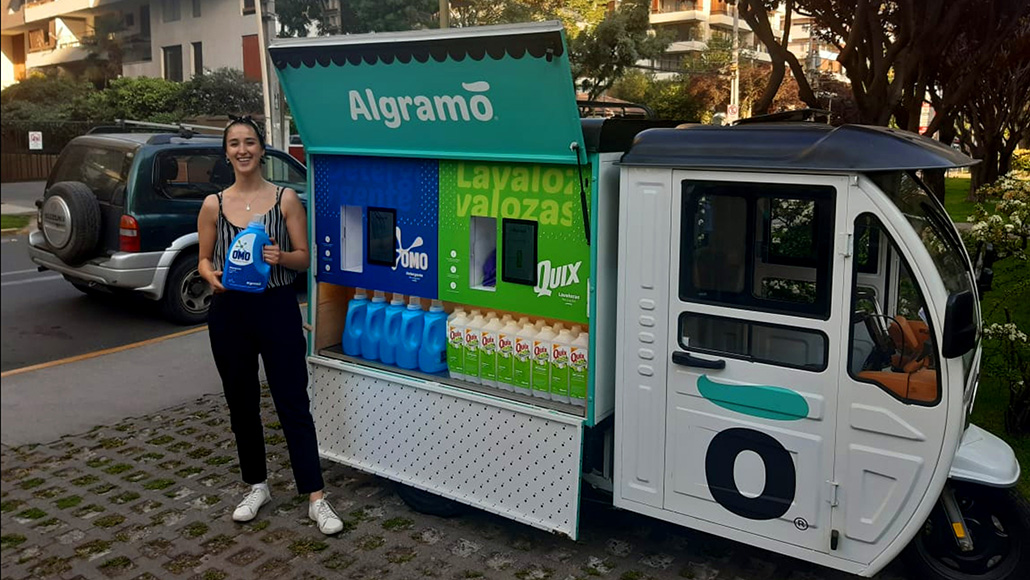
Already in partnership with brands like Unilever, Algramo’s smart packaging reimagines the future of grocery shopping while eliminating single-use plastic packaging waste.
Contact: [email protected]
October 14 – Closed Loop Partners, a New York based investment firm focused on building the circular economy, announced today its investment in Algramo through its venture capital fund, Closed Loop Ventures (CLV).
Founded in 2012, Algramo is a Chilean based startup solving economic and environmental issues through its vending machines that dispense staple products, like household cleaners and grains “by the gram” to customers.
Jose “Cote” Manuel Moller, Founder and CEO of Algramo, saw first-hand in Santiago, Chile, how those living in low income neighborhoods were penalized by an effective 40% “poverty tax” for purchasing smaller packaged consumer products, unable to afford larger-format products.
“By creating low-cost reusable packaging and reducing the cost of distribution through our vending machines and dispenser system, we dramatically cut costs for customers and allow them to purchase small quantities of products at an affordable price. This benefits brands too who want to sell product, not packaging. Our system easily integrates into local bodegas, large grocery store chains, and can be delivered to a customer’s home through our mobile delivery app.”
Cote, Founder and CEO of Algramo
Awareness around the negative impacts of single-use packaging on human health and the environment is growing too. Packaging is ending up where it shouldn’t; in landfills, our oceans, or even as a contaminant in the recycling system.
“Reusable models like Algramo’s are an important and necessary step in the reduction of single-use plastic packaging. Algramo is a leading innovator showcasing a circular solution to a global waste issue by ensuring that valuable materials are kept in play for multiple uses.”
Danielle Joseph, Executive Director at Closed Loop Partners
Algramo’s smart packaging, equipped with RFID chips, also encourages and accelerates positive consumer behavior change so that individuals can easily and conveniently embrace a reuse revolution. Each time a customer refills their existing container or bottle with product, they earn credit that can be applied to future purchases, equating to an 11.5% discount on their next liter of detergent for example; the more the packaging is used, the more value it accrues.
Algramo already operates in over 2,000 family owned stores that reach over 325,000 end-customers in Santiago de Chile. Their business model has attracted the attention of a number of large brands, including Unilever, which is currently partnering with Algramo to pilot a mobile dispensing system that uses electric tricycles to deliver products to people’s homes via an app. Algramo was selected as a winner of the MIT SOLVE Circular Economy challenge. Algramo is now looking to expand their operations into the U.S. and beyond.
Closed Loop Ventures is leading Algramo’s Series A round. CLV makes early-stage equity investments in sustainable consumer goods companies, advanced recycling technologies, and services related to the circular economy – reducing waste or closing the loop on various materials. To date, CLV has invested in 18 companies spanning a number of sectors: recycling, textiles and apparel, and food and agriculture.
About Closed Loop Partners
Closed Loop Partners is an investment platform that invests in sustainable consumer goods, recycling and the development of the circular economy. Investors include many of the world’s largest consumer goods companies and family offices interested in investments that provide strong financial returns and tangible social impact. Learn more at www.closedlooppartners.com.
About Algramo
Algramo came into existence to solve a problem impacting millions of low-resource families: the poverty tax. This market failure occurs when low-resource families buy products in small formats and pay up to 50% more for products. Algramo solves the poverty tax with a reusable packaging distribution system that enables families to buy the exact quantity of products they need with bulk prices. Algramo is honored to bring together brands, retailers and packaging producers to work towards catalyzing reusable packaging on a globally significant scale to keep packaging in the economy and out of the environment.
LOLIWARE: The Seaweed Straw of the Future

We caught up with Chelsea Briganti, founder and CEO of LOLIWARE, while onboard the National Geographic’s ship, SeaBird, for the first week of the Sustainable Ocean Alliance’s (SOA) Accelerator at Sea this September. LOLIWARE was part of the inaugural cohort of SOA’s ocean-tech focused accelerator in 2018.

Chelsea Briganti, Founder & CEO of Loliware
LOLIWARE is a Closed Loop Ventures’ portfolio company that is pioneering biomaterials derived from seaweed to replace plastics; healing the planet by making single-use plastics obsolete.
Born in Hawaii, Chelsea grew up feeling a strong connection to the ocean, where she was baptized, nourished, and calmed by the waves throughout her childhood. This, along with her industrial design background and desire to use her skills to create a better planet, have helped propel LOLIWARE forward. The company is now working with several Fortune 500 companies and partnering with Marriott and Pernod Ricard to disseminate millions of plastic-free straws.
We sat down with Chelsea to catch up on the latest news. This interview has been condensed and edited for clarity.
With the help of a team of material scientists, food technologists, seaweed biologists, and biopolymerists, LOLIWARE wants to replace the 360 billion plastic straws used globally every year. How far along on this journey are you?
We’re currently underway with a massive scaling effort. This is where most startups completely drop the ball. They have a great idea, it could be world-changing, but they struggle to take it from the lab to mass scale.
Fortunately, I learned a lot from our initial work at LOLIWARE on the cup. We were creating a cup that you could eat rather than throw away. It was an interesting idea and helped put us on the map, but we dropped the ball on the manufacturing side. I learned that LOLIWARE’s strength and core competency, our real sizzle as a company, is our material technology and innovation pipeline, it’s not that we’re manufacturing geniuses.
What we are is a leading materials innovation technology company. This means that we continue to pioneer biomaterials derived from seaweed to replace plastics at scale. We’re doing this by inventing new materials and inventing the process to scale these new materials. We can then take these two blueprints to a plastic manufacturer, for example, and license them. Plastic manufacturers will be dinosaurs unless they evolve with current regulatory and market forces. There are tons of bans on plastics and millennials don’t want plastic anymore. We’re pitching a new technology to help manufacturers evolve with the times.
LOLIWARE’s straw feels just like a traditional plastic straw, but it’s 100% plant-based, hyper-compostable, and marine degradable. What’s the significance of seaweed in your mission to heal the ocean?
The reason seaweed is so special is because it sequesters carbon as it grows and has a fast, renewable lifecycle of four to six weeks. What comprises the seaweed is cellulose, naturally occurring polymers, and proteins. All of these represent opportunity. They can be used for other packaging innovations, for example, you can create a SeaPulp™ by extracting cellulose from seaweed. This can be formed into any shape, with the added benefit of avoiding any health issues associated to PFAs.
When you look at our competition, the only consequential one is paper. You’ve got tons of fiber companies on the scene and China has said that their solution to plastic is paper. But, you’re going to start seeing backlash against paper. In some cases, paper has a worse carbon footprint than plastic because of its inputs: Trees have a long lifecycle and often you have to transport them thousands of miles for processing. We are tree-free and rainforest-free, believing that these precious carbon sinks should remain intact versus be used for packaging.
Seaweed is definitely part of the future of replacing plastic. All of our seaweed is sustainably sourced. Our supplier in Europe harvests it in accordance with strict regulations. Right now, less than 1% of it is harvested and, in turn, LOLIWARE only uses a fraction of that.

LOLIWARE has already built a strong and recognizable brand, appealing to consumers who want to avoid plastics, toxins, and GMO products, among other things. How important has branding been for growth?
You have to have a killer technology, but you also have to have a killer brand, especially given the current climate. I got a lot of push back from early-on investors in LOLIWARE. They felt like we were wasting time, asking “Why do you even have a social media presence?” But I always knew they were wrong. We’re B2B2C and we’re a movement to go plastic-free. We’re also a technology to replace plastic. Both of these things come together. That’s the secret sauce. There is no brand of paper straws or corn-based plastics that people identify with, yet people connect with LOLIWARE. It’s important to be clever, to be fun, and to have beauty in sustainability when it comes to branding.
We also really focus on being a women-empowered brand. For the longest time, women’s inventions have been sitting on the sideline – underfunded and underdeveloped. Yet, women have a lot of buying power and care about sustainability. Now is the time to rally them. We need more women in leadership to solve the problems of the ocean and the planet.
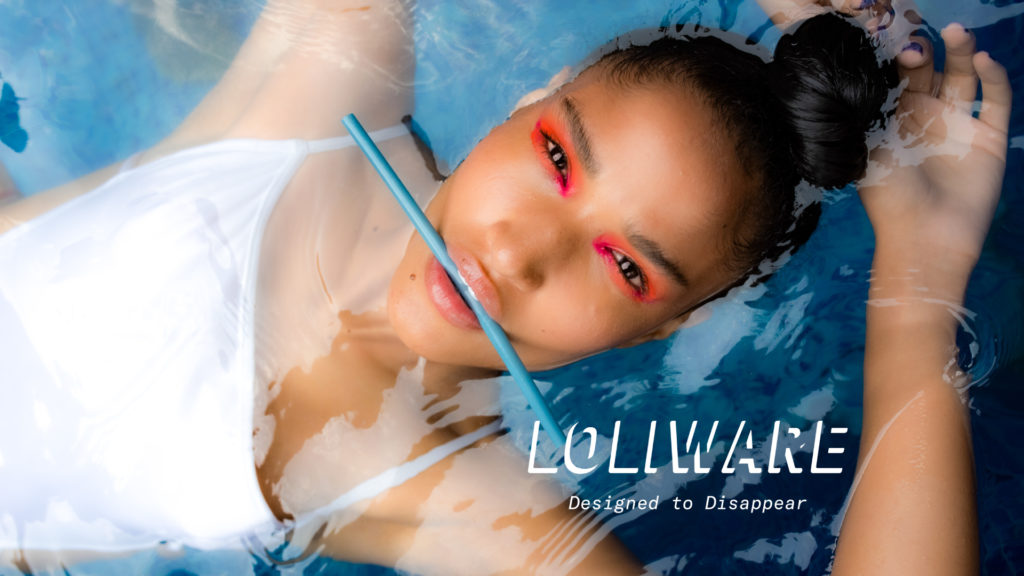
And lastly, we can’t ignore the incredible natural environment we’re in right now as we head toward Sitca, Alaska. How do natural backdrops like this help to inspire your work?
When you’re an entrepreneur you can easily sequester yourself in the office and become hermetic. For me, I’m inspired by nature’s vast expanse. I love how Charles Eisenstein expresses the importance of being in places where the dream of the planet still lives. You definitely feel that here. It’s the dream of the planet, a pristine natural environment. You get the visceral sense that you are on the planet versus in a manmade landscape like New York City. Too often we’re in landscapes where everything is made by us and we can quickly become disconnected from the natural world. It’s important to be able to take the mental image of the dream of the planet back to your work. It’s what we’re trying to protect or even recreate in places where the dream of the planet is dead or dying.
The Latest Insights and Analysis from Chris Cui, Director of Asia Programs
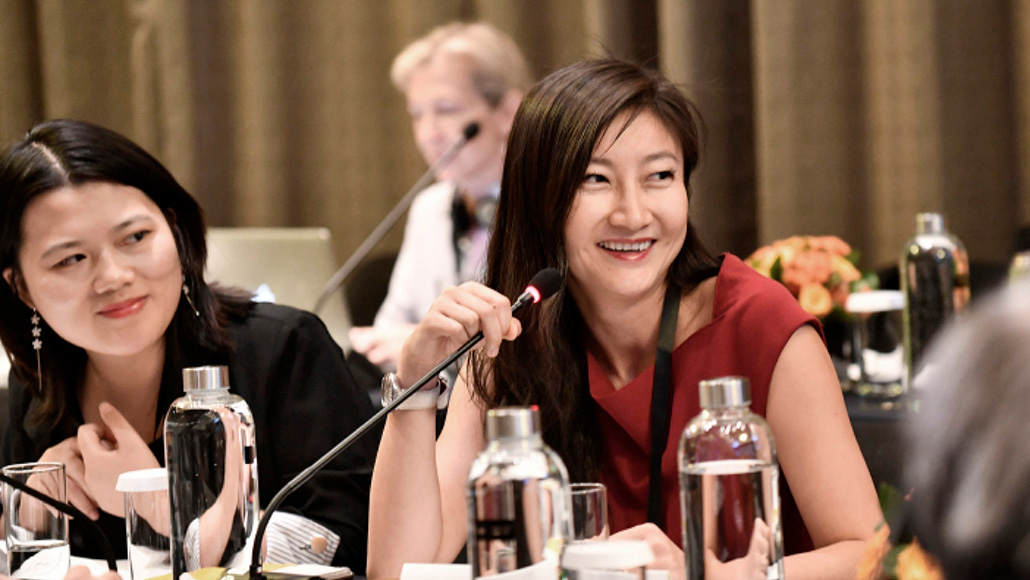
The revision of China’s Solid Waste Management and Pollution Prevention Law could have far reaching impact on brands and recyclers.
A proposed revision to the Solid Waste Management and Pollution Prevention Law in China could affect the operations of brands and recyclers. The revised law entered the review phase at the 13th National Congress on June 25, 2019 and is now seeking public opinion. Below are some key implications of the clauses:
Impact on the packaging industry
Clause 2.13: Companies that produce, use, and store solid waste (SW) should publish their waste management information. Publicly listed companies must also publish their preventive measures against SW pollution.
This represents a significant departure from current protocol. Increased transparency and mandatory reporting requirements for public companies will incentivize companies to invest in SW prevention, potentially providing reputational rewards to those best-in-class. This kind of impact oriented investment fits nicely with the growing interest in ESG investing in China.
Clause 3.20: Producers of SW must pay Environmental Protection Tax.
This would add a new expense for manufacturers that could be passed onto consumers too. The commercial real estate sector in China recently had to adjust to the introduction of this, where previously they did not have to worry about their waste management expenses.
Clause 3.21: The design and production of packaging must follow green production standards that will be set up by the State Market Regulation to reduce waste generation. Producers of materials that fall under mandatory recycling categories must be responsible for the recycling of their materials. The list of mandatory recycling materials will be produced by NDRC (National Development and Reform Committee).
Clause 3.22: The government will encourage R&D institutes and producers to develop and use materials that can be easily recycled, safely stored, and that can decompose in a natural environment. Packaging materials that can’t be easily composted will be banned.
Clause 3.21 and 3.22: It’s encouraging to see that the government is not only promoting recycling, but also the reduction of waste through circular design and materials innovation. This will force brands to adopt circular packaging principles, so there will be a lot of room for innovation in eco-friendly packaging.
Clause 3.42: There will be EPR for electric appliances and other products.
Since 2018, this kind of EPR has been in effect for electric vehicle manufacturers, requiring better lifecycle management across the value chain – from product design and consumption to the recycling and waste management related to electronic vehicles at end-of-use.
Impact on the recycling industry:
Clause 3.28: Permits must be required for the transportation of SW across cities.
Demand for distributed, modular recycling units will grow so that waste can be processed more locally. The need for smart logistics will grow in tandem to optimize for more efficient transportation routes, among other things.
Clause 3.29: There should be a complete solid waste import ban by 2020.
While there has been a lot of speculation in the U.S. regarding whether or not China will implement a total waste import ban by late 2020, as declared in 2017, it is clear that the Chinese government plans to move ahead with this.
Clause 3.57: There will be differential charging schemes for residential waste.
The mandatory sorting of residential waste was introduced in certain pilot cities in China on July 1, 2019. In a district in Shanghai, it now costs $17 USD to dispose of 120 liters of food waste. You can read more about this on our blog on Recycling Rises to Power in China.
Although we do not know how likely it is that all of the proposed revisions will pass or when, the fact that there are so many proposed changes to the current law, which came into force in 1995, and that they’ve gone all the way to the desk of the National Congress, is a signal that waste management is a high priority for the central government. By reviewing the proposed changes, companies in China and abroad can better prepare for what’s coming down the line.
Unlike Europe, where the circular economy is championed by investors, the government, and consumers, in China it’s the government taking the driver’s seat. The proposed revisions to the law illustrate the steps the government is willing to take to develop the circular economy in China. In turn, industries are taking note and are seizing the subsequent business opportunities.
I would encourage brands that consider China as one of their key markets to give serious thought on how they can create a circular advantage to meet the growing demand for sustainable products in China before their competitors do. This will be critical in a context where a country is implementing increasingly strict solid waste management laws.
The reform on plastic pollution in China, the next big thing after National Sword?
At the 10th meeting of the Central Committee for Deepening Overall Reform on September 9th, chaired by the Chinese President, plastic waste reform was listed as a key issue. The following was cited:
“Actively responding to plastic pollution by restricting the production, sale, and use of some plastic products, actively promoting recyclable and biodegradable substitute products, and regulating plastic waste.”
We are still waiting for a detailed reform plan, but this is another huge boost for the development of a circular economy in China, supported by the government. Brands and recyclers in China and overseas should start to prepare for the changes brought by a reform like this.
The Key Takeaways from Fortune’s First Global Sustainability Forum:
This September, in Yunnan, China, I attended Fortune’s first Global Sustainability Forum, speaking on a panel on Waste Not. The Forum dived deep into the business opportunities and challenges that arise from the transition from a linear to circular economy, highlighting the following key points:
- There are three key driving forces behind circularity: increasing shareholder activism and interest in public companies’ ESG commitments; public awareness among consumers on the environmental footprint of products and services; and growing regulation in Europe and Asia to tackle waste issues, especially plastic pollution.
- Finance is slowly but surely reckoning with the economic risks posed by climate change and other environmental threats. ICBC, the world’s largest bank by assets, ran a stress test in 2015 and, we learned, issues higher interest loans to firms that are over-exposed to environmental hazards. The stress tests began in 2015, and have changed the way Chinese banks look at the businesses they fund, now reducing their exposure to coal projects and increasing their exposure to renewable energy.
- Building sustainable supply chains is challenging due to limited transparency around data, a lack of focused financing, and water and waste management typically being too cheap to account for negative externalities. Labor specific issues also often take precedence.
Closed Loop Partners Acquires a Stake in Balcones Resources to Further Advance Recycling and the Development of the Circular Economy
October 03, 2019
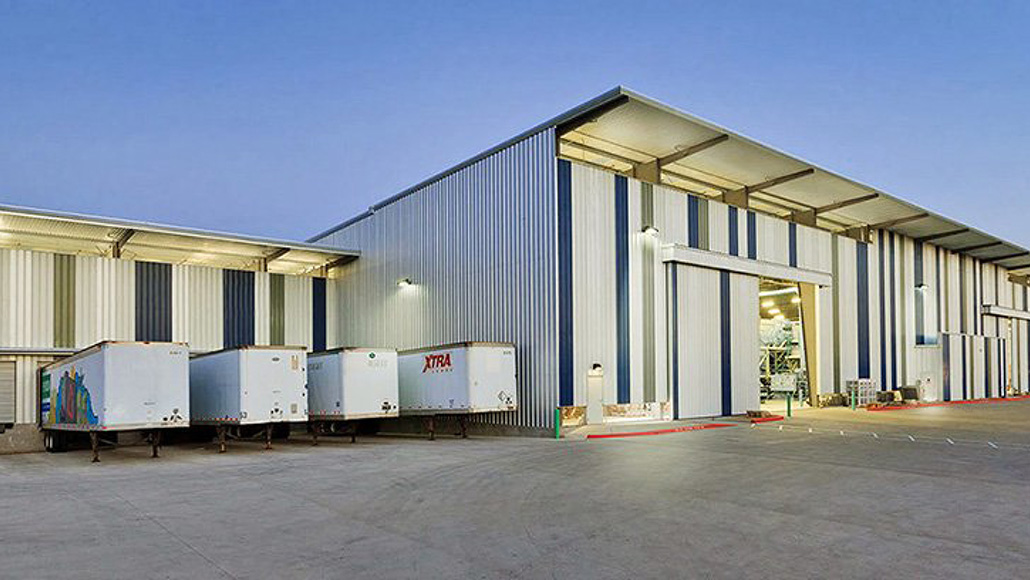
Closed Loop Partners and Balcones Resources will expand recycling and circular economy infrastructure and services across the United States, recapturing valuable materials and returning them to the manufacturing supply chain.
Contact: [email protected]
October 3 – Closed Loop Partners, a New York based investment firm focused on building the circular economy, announced today the acquisition of a stake in Balcones Resources through its private equity fund, the Closed Loop Leadership Fund.
Balcones Resources is a nationally recognized, best-in-class environmental services company that has been in business for 25 years, handling commercial and residential recycling, among other services, in Texas and Arkansas. Their commitment to operational excellence, advanced technology, and long-term partnerships makes Balcones an ideal platform to scale the circular economy within their current markets and across the United States.
Kerry Getter, Chairman and CEO of Balcones will continue to lead the company. Getter says,
“The expertise that Closed Loop Partners brings to the new relationship will provide unprecedented opportunities for corporate management and shareholder growth. Balcones and Closed Loop Partners’ cultures are similarly aligned. Together, we will be able to enhance employee opportunities, services to our customers, and assist in achieving a diverse set of ambitious environmental goals.”
The partnership builds on Closed Loop Partners’ extensive network of strategic stakeholders across the recycling and manufacturing value chain, from supplier relationships with corporate partners to recycling facilities to manufacturers across the United States. By better connecting and integrating the system, costs and volatility in the market are reduced.
“We’re investing across the supply chain with a long-term view of a more profitable and sustainable future. By scaling best-in-class businesses like Balcones, we will strengthen recycling and circular economy infrastructure in the U.S.”
Ron Gonen, CEO of Closed Loop Partners
The Closed Loop Leadership Fund brings together corporate investors, institutional investors, family offices, and foundations committed to building circular supply chains that reduce costs, increase margins, and protect the environment we share.
About Closed Loop Partners
Closed Loop Partners is an investment platform that invests in sustainable consumer goods, recycling and the development of the circular economy. Investors include many of the world’s largest consumer goods companies and family offices interested in investments that provide strong financial returns and tangible social impact. Learn more at www.closedlooppartners.com.
About Balcones Resources
Balcones Resources began operations in 1994 and has grown into a nationally recognized firm and one of the top 50 recyclers in North America. With more than 200 employees across its three locations, Balcones is a recycling partner for municipalities, multi-tenant facilities, corporate campuses, manufacturing facilities and distribution centers. For more information on Balcones Resources and its environmental services, visit BalconesResources.com.
Disclaimer:
This publication is for informational purposes only, and nothing contained herein constitutes an offer to sell or a solicitation of an offer to buy any interest in any investment vehicle managed by Closed Loop Capital Management or any company in which Closed Loop Capital Management or its affiliates have invested. An offer or solicitation will be made only through a final private placement memorandum, subscription agreement and other related documents with respect to a particular investment opportunity and will be subject to the terms and conditions contained in such documents, including the qualifications necessary to become an investor. Closed Loop Capital Management does not utilize its website to provide investment or other advice, and nothing contained herein constitutes a comprehensive or complete statement of the matters discussed or the law relating thereto. Information provided reflects Closed Loop Capital Management’s views as of a particular time and are subject to change without notice. You should obtain relevant and specific professional advice before making any investment decision. Certain information on this Website may contain forward-looking statements, which are subject to risks and uncertainties and speak only as of the date on which they are made. The words “believe”, “expect”, “anticipate”, “optimistic”, “intend”, “aim”, “will” or similar expressions are intended to identify forward-looking statements. Closed Loop Capital Management undertakes no obligation to update publicly or revise any forward-looking statements, whether as a result of new information, future developments or otherwise. Past performance is not indicative of future results; no representation is being made that any investment or transaction will or is likely to achieve profits or losses similar to those achieved in the past, or that significant losses will be avoided.
Six Companies Graduate from the NextGen Circular Business Accelerator Ready to Scale Their Sustainable Cup Solutions
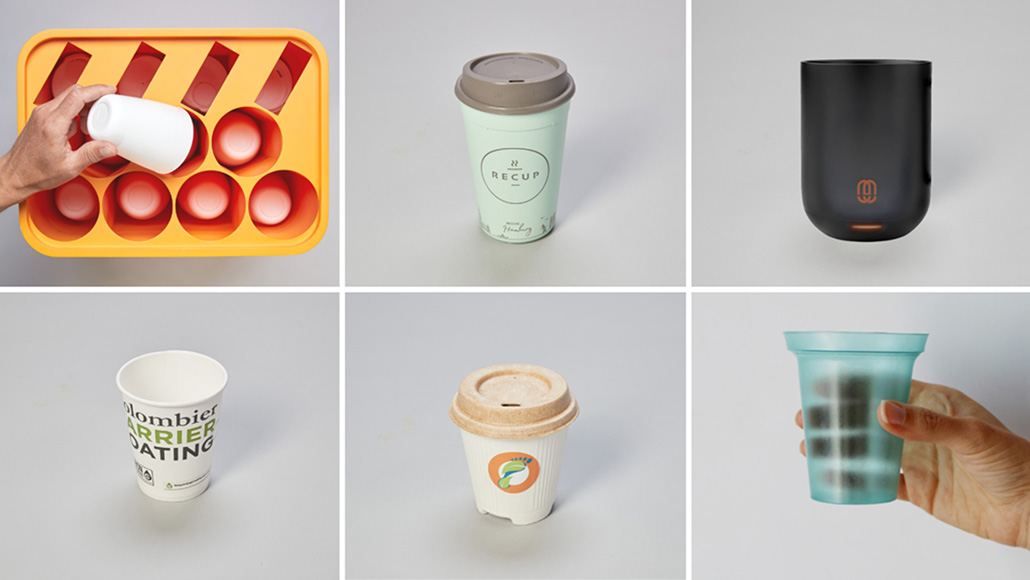
The NextGen Consortium, a pre-competitive collaboration managed by Closed Loop Partners in partnership with Starbucks and McDonald’s, accelerates towards a more circular cup system.
Contact: [email protected]
September 25 – NextGen Consortium Partners, investors, and other stakeholders convened during Climate Week in New York City for a Demo Day in which six participants in the NextGen Circular Business Accelerator showcased their manufacture-ready prototypes and pitch-ready business plans for growing their sustainable cup solutions.
The Accelerator follows Closed Loop Partners’ announcement of 12 NextGen Cup Challenge winners in February 2019. Six winning teams entered the NextGen Circular Business Accelerator, launched in partnership with global design firm IDEO to help companies further refine their cup solutions through rapid learning and iteration. The diverse solutions include cutting-edge plant-based materials, new innovative liners for cups, and reusable cup systems that redesign the fiber to-go cup so that it is more widely recoverable or remains in circulation for multiple uses. The six teams participating in the Accelerator are Colombier, CupClub, Footprint, Muuse, RECUP, and SoluBlue.
During the rigorous, six-month Accelerator program, companies accelerated their learnings through live in-context prototyping across four distinct Google campus locations, each housing multiple cafes. Progress for each cup solution was measured across four key categories: customer experience, server experience, performance, and disposal. Companies were able to see first-hand how customers and servers interact with their cups in a restaurant-like environment, capturing real-time feedback in a low-risk setting and identifying areas for refinement.
Companies also visited materials recovery facilities and explored the recovery side of the cup value chain, learning about the systems and infrastructure in place to ensure that their solutions are in alignment. Additionally, companies studied the value of materials recovered post-processing of their cups in order to make the economic case for more circular approaches.
Throughout the Accelerator, companies gained invaluable feedback through direct engagement with NextGen Consortium Partners, including founding partners Starbucks and McDonald’s, supporting partners The Coca-Cola Company, Yum! Brands, Nestlé, and Wendy’s, advisory partner WWF, and innovation partner IDEO. Feedback included insight into what it would take to roll out their solutions at a large scale.
“We are proud of the NextGen collaboration underway with so many companies championing greener cup technologies. We applaud Closed Loop Partners’ continued, on-track progress to determine what’s most viable, and we are excited for our own customers to try greener cups in our stores in the near future.”
John Kelly, senior vice president, Global Public Affairs & Social Impact at Starbucks
The companies were also welcomed behind the scenes of a McDonald’s restaurant to better understand how cups work within a store’s layout and staff operations.
“We were thrilled to have participants in the NextGen Circular Business Accelerator experience. Having these next gen solutions in our restaurants to see first-hand how our crew members manage through our restaurant operations is an important step. Compatibility with the fast pace of a QSR setting is critical, and it was great to see Accelerator teams jump at the opportunity to better understand these in-restaurant conditions. These cup solutions are helping shape the future of packaging, and we want to set them up for success while keeping valuable materials in circulation and, importantly, out of landfills and our oceans.”
Marion Gross, Senior Vice President and Chief Supply Chain Officer, McDonald’s USA
“Seeing how far participants in the NextGen Circular Business Accelerator have come is truly rewarding. The NextGen Consortium will continue to work with winning teams to ensure that when their solutions do enter market at scale they’re set up for success and recoverability.“
Kate Daly, Managing Director of the Center for the Circular Economy at Closed Loop Partners
The other six winners of the NextGen Cup Challenge, which are later-stage in their development, are working with the NextGen Consortium to identify in-market piloting opportunities in regions across the globe. Some participants in the NextGen Circular Business Accelerator are also expected to announce in-store pilots as early as 2020.
The Cup Challenge and the NextGen Circular Business Accelerator are just one part of the NextGen Consortium’s efforts to address single-use food packaging waste globally by advancing the design, commercialization, and recovery of food packaging alternatives. The Consortium is also focused on infrastructure and consumer engagement, supported by stakeholder collaboration across the value chain.
“Watching the aggregation of innovative ideas turn into real progress has been exciting to watch. Now we’ll look to the members of the NextGen Consortium to take these solutions into the marketplace and watch real change happen.”
Erin Simon, Director, Sustainability R&D, World Wildlife Fund
About NextGen
Each year, an estimated 250 billion fiber to-go cups are distributed worldwide. Most of these are not recyclable or compostable. The NextGen Consortium and Cup Challenge launched in 2018 to bring together entrepreneurs, industry, and recyclers to identify and commercialize the next generation of recyclable and/or compostable cups. Closed Loop Partners, Starbucks, McDonald’s, The Coca-Cola Company, Yum! Brands, Nestlé and Wendy’s invite the industry to join this effort to identify a global solution to this shared challenge.
About Closed Loop Partners
Closed Loop Partners is an investment firm that invests in sustainable consumer goods, recycling, and the development of the circular economy. Investors include many of the world’s largest consumer goods companies and family offices interested in investments that provide strong financial returns and tangible social impact. In 2018, Closed Loop Partners launched the Center for the Circular Economy, a New York City-based collaboration center for innovators to commercialize products, services, and technologies that are leading the transition from a linear take, make, waste economy to a restorative one in which materials are shared, re-used, and continuously cycled. Learn more at www.closedlooppartners.com.
About McDonald’s
McDonald’s is the world’s leading global foodservice retailer with over 37,000 locations in over 100 countries. Over 90 percent of McDonald’s restaurants worldwide are owned and operated by independent local business men and women. This year McDonald’s announced a series of commitments demonstrating how it will use its Scale for Good to positively impact the planet and the communities it serves. You can read more about McDonald’s Scale for Good initiatives here.
About Starbucks
Since 1971, Starbucks Coffee Company has been committed to ethically sourcing and roasting high-quality arabica coffee. Today, with stores around the globe, the company is the premier roaster and retailer of specialty coffee in the world. Through our unwavering commitment to excellence and our guiding principles, we bring the unique Starbucks Experience to life for every customer through every cup. To share in the experience, please visit us in our stores or online at http://news.starbucks.com or www.starbucks.com.
NextGen Consortium Partners
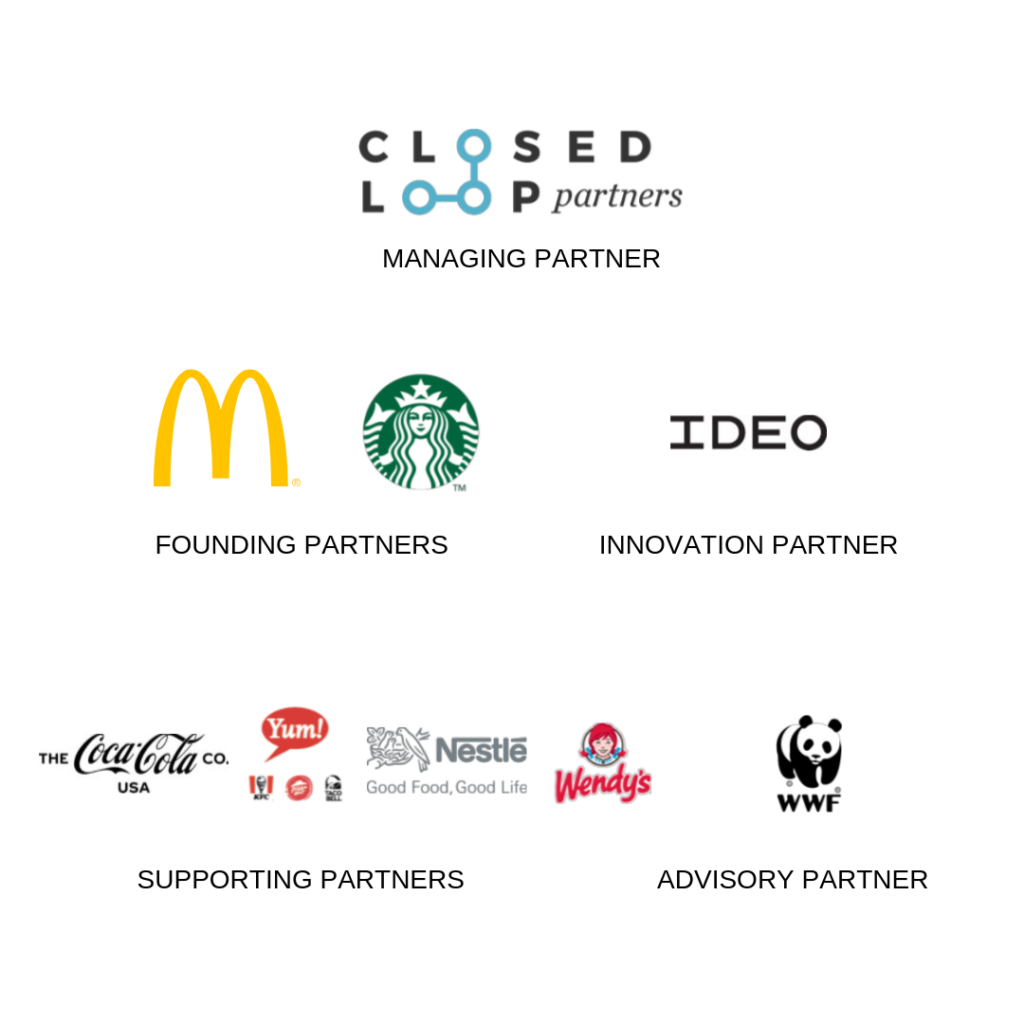
How to Use Design Thinking to Advance Systemic Change, One Cup at a Time
August 05, 2019
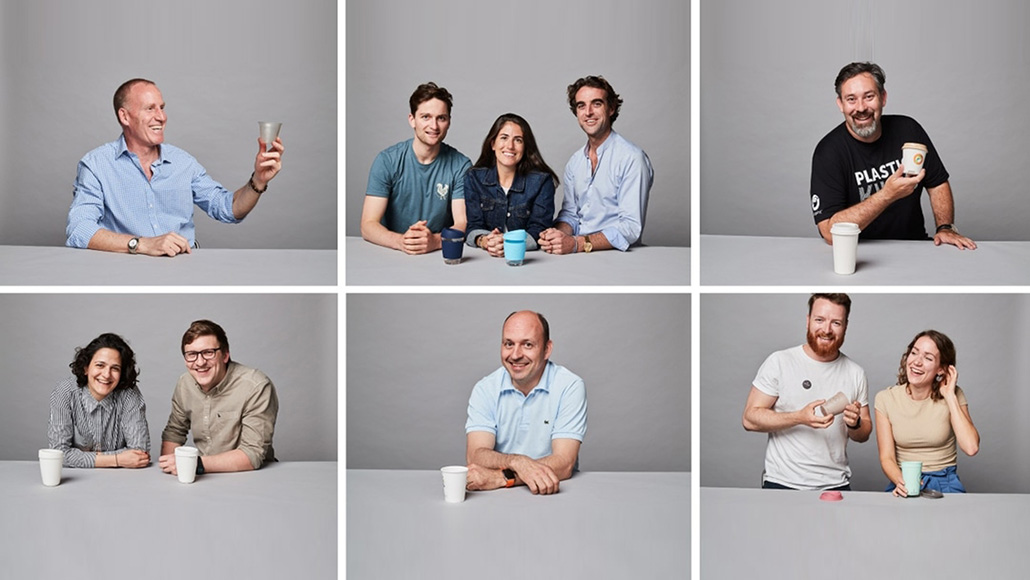
Amid burbling espresso machines and towering stacks of cups, six teams in the NextGen Circular Business Accelerator are taking waste-free cup solutions to the next level. Venturing back of house at restaurants and into the world of waste management, see how teams use five design thinking practices to advance solutions for a more circular future.
The NextGen Consortium is a global initiative convened by Closed Loop Partners’ Center for the Circular Economy. Starbucks and McDonald’s are founding partners of the Consortium, together with supporting partners The Coca-Cola Company, Yum! Brands, Nestlé and Wendy’s, as well as WWF as an advisory partner. OpenIDEO is the Consortium’s innovation partner.
If you’re looking for a systemic challenge in need of some new thinking, look no further than your morning cup of coffee. Worldwide, 250 billion to-go cups are produced each year, and there’s an increasing need for recoverable alternatives. Most fiber cups have a plastic liner to prevent leaks. The fiber and plastic are recyclable once separated, but limitations and inconsistencies in recycling infrastructure around the world mean that in most markets these materials aren’t easily recovered. The trouble is, as OpenIDEO Circular Program Lead Chris Krohn explains,
“When we have a systems design challenge, we can’t expect to solve it using the same approach that created the problem. It’s essential to understand the issue from perspectives across the entire value chain, and then work across that system to develop a holistic solution.”
In pursuit of some fresh ideas, Closed Loop Partners launched the NextGen Consortium: a multi-year partnership of food and beverage industry leaders that aims to address global single-use food packaging waste. Up first, the ubiquitous hot and cold, fiber-based, to-go cup. The NextGen Cup Challenge identified twelve innovators with the most promising cup solutions – from new cup liners to reusable cup systems. Of those, six winning teams (pictured above) joined the NextGen Circular Business Accelerator, an initiative to help prepare the teams for testing and scaling their solutions to meet the needs of today’s biggest brands and consumers worldwide.
Before rolling out new cup solutions in a real-world setting, it was essential for Accelerator teams to understand the customer needs, business realities, infrastructure challenges, and people at the core of the cup ecosystem. In a week-long design Bootcamp that took us behind counters and across the San Francisco Bay Area, OpenIDEO, with support from Closed Loop Partners, led teams through five design thinking practices to quickly surface new insights and inspiration. Try them out yourself the next time you’re working on a complex problem.
1. Center on a plan for informed, effective research
Design a fresh perspective. An essential part of the design thinking process is design research: exploring what people say, think, do and feel to help build human-centered solutions. This often means getting out into the field to meet people where they are, which helps us understand real needs and imagine what’s next. As Nina Montgomery, an IDEO design researcher, shared with NextGen Accelerator teams at the start of the Bootcamp,
“The power of design research is that—through empathy and inspiration—it is able to surface new thinking.”
Start with what you know. Before jumping into the field, it’s helpful to curate some background knowledge. We worked with each Accelerator team to compile insights from desk research—across internal documents, datasets, and market, competitor and business plan analysis—to get a sense of what was known and what we needed to test. Some teams, like RECUP from Munich, Germany, plan to roll out systems involving reusable cups, while others, like Solublue from London, UK, are building biodegradable cup solutions from new materials. Despite this diversity in business models, every team needed to know how consumers and distributors would respond to their particular cups. We also took into consideration the needs of Consortium Partners like McDonald’s and Starbucks to help identify any gaps and inform the key questions each team had to answer to set themselves up for scale.
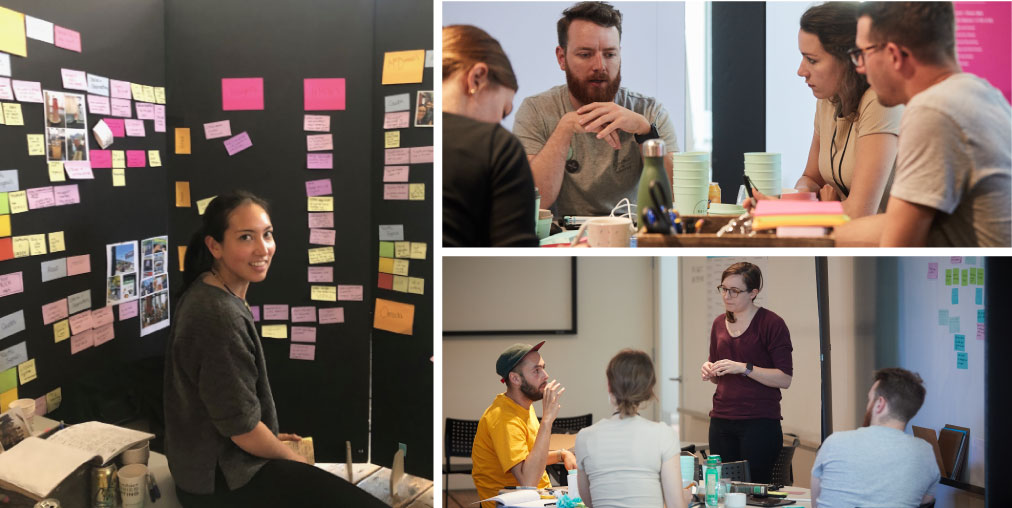
NextGen Circular Business Accelerator teams make a plan for their design field research.
Develop a research game plan. With this in mind, we kicked off the Bootcamp by developing a design research plan. This included deciding on research methods, team roles, and questions to ask in the field, and ensuring we were integrating research ethics. Building on background research, we helped Accelerator teams identify and schedule time to visit the kinds of people and places that would surface valuable, diverse insights about the to-go cup ecosystem. Together, we synthesized research questions in a discussion guide that was shared with each team member, ensuring that field research focused on what mattered most. Armed with a plan, a notebook, Sharpies, and lots of Post-Its, we were ready to hit the streets of San Francisco.
Try it:
- Explore a variety of design research methods in Design Kit.
- Focus in on your key research questions using this Design Research Discussion Guide.
2. Gain micro-level insights through observation
Watch and learn. That’s how, on a bright Tuesday morning, a group of IDEO designers and Accelerator entrepreneurs found ourselves attentively watching a stream of cups dance between hands and over counters at a San Francisco McDonald’s. Observation is a key method of design thinking. By taking a step back and looking carefully, we can better understand systems at a micro level.
At McDonald’s, observing employees interact with cups soon surfaced some fresh insights. To keep up with the lunch rush, cups must be easy to grab with one hand, nest well but also release easily from a stack, and communicate branding. Through observation, Accelerator teams quickly built empathy for the employees and identified how their new cups would or would not meet McDonald’s needs. By allowing us to observe their operations, McDonald’s was able to easily communicate their business realities and product requirements in a way that would have been impossible through words alone.
“Everyone knows McDonald’s, but how many people can say they’ve experienced the back of house logistics required to operate one? The Bootcamp provided opportunities like this that startups only dream about, and catapulted our growth potential in ways we’ll still be processing months later.”
Lizzie Horvitz, one of the Accelerator participants
Try it:
- Observation is simple. Grab a notebook, a pen, & scope out a good place to watch & listen.
- Find tips for getting started in this quick Design Research Field Guide from IDEO.
3. Uncover disconnects and trends with interviews and intercepts
Listen for gold. To fully understand what someone is thinking or feeling, we’ve found it’s often best just to ask. Building on our observations, we set up interviews with baristas, managers, and more, asking open-ended “how” and “why” questions that encouraged them to speak freely.
What we heard was a surprising amount of confusion around cup disposal best practices. In one coffee shop, baristas were told to compost cups, while the trash bins in the shop had signs instructing customers to recycle—both instructions contrasting with San Francisco waste management company Recology’s guidelines. User interviews helped teams identify pain points and systemic disconnects which would have been tough to spot without talking to the people on the ground.
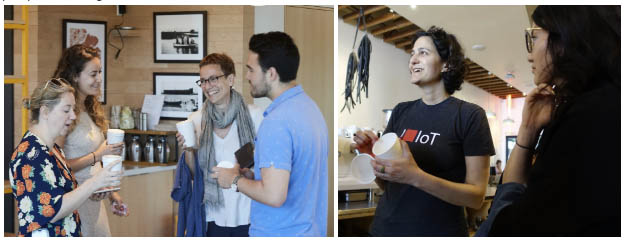
Teams gather user feedback on their cup designs and systems during intercepts and interviews.
Intercept for quick insights. The trouble with interviews: they can take time to set up. That’s why we also practiced intercepts— brief moments of connection with users that allowed us to capture impressions and test assumptions in real time. Conducting an intercept is as simple as walking up to a friendly face, introducing yourself, and asking a single important question.
The Footprint team—offering fully formed fiber-based cup solutions—tried out intercepts in a coffee shop, surveying customer opinions on their brown fiber cup vs. their more traditional white cup. The responses were intriguing. In general, millennials seemed to prefer the brown cup, describing it as “natural,” while older generations felt it looked “dirty.” By compiling responses, intercepts helped our teams quickly identify demographic trends and interests that would help define their future product offerings.
“Field research during the bootcamp showed us that there is potential to improve our cups and lids both for convenience and recyclability. We also got better insights into how logistics and incentives around the cup system might need to be adapted for the US market.”
Alexandra Gurstmeier of ReCup
Bring it all together. After every field research session, it’s important to debrief to ensure insights aren’t lost. With each Accelerator team, we’d synthesize—transferring notes from observations and interview guides onto post-its, sticking them up on a board, and grouping where we saw trends. This process helped the teams identify the essential flags, opportunities, and business considerations that surfaced in their research.
Try it:
- Use this Interview Guide to shape consumer conversations and ask strong questions.
- Fill out an Intercept Worksheet to get set up for these quick moments of connection.
4. See a challenge with fresh eyes through analogous experiences
Learn from others. Paradoxically, sometimes the best way to think differently is to seek what’s similar. Analogous research takes a look at different industries to find inspiration in the ways others have tackled similar challenges. During the Accelerator, we paired teams with organizations that have successfully worked through an issue our teams were currently facing. For example, the Solublue team—offering a plant-based, biodegradable cup solution—is currently preparing to ramp up its production. The team toured the Dandelion Chocolate factory for an inside look at how they set up and scaled their manufacturing process.
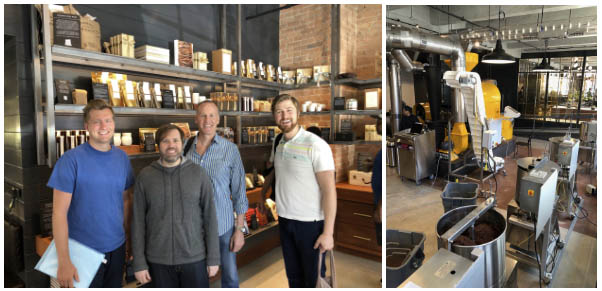
The Solublue team and IDEO design researchers explore the manufacturing systems of Dandelion Chocolate as analogous research.
Meanwhile, the CupClub team, which creates reusable cups people can pick up in a coffee shop and deposit at dedicated drop points around their city, found inspiration from an unusual source: rentable electric scooters. While cups and scooters may not seem to share much in common, CupClub learned from the Spin team how they managed the “economies” that popped up around their scooters, which provided quick cash for people willing to collect and recharge the scooters at home. This insight led to an interesting question for the CupClub team: how might we build economies of support around a reusable cup model that promote sustainability and job creation?
As the teams found, analogous research is a great way to gain a new perspective, learn from other’s struggles and successes, and help break through entrenched thinking.
Try it:
- Brainstorm: what other industries are tackling problems similar to the ones you are facing? What can you learn from their approach? Use this analogous inspiration exercise as a guide.
5. Map the existing infrastructure to define the path forward
Get real. To design sustainably, it’s essential to understand and integrate into the existing ecosystem that will touch a product over its lifecycle. Mapping how each team’s solution fit within the broader cup recovery infrastructure was crucial to ensure their cups would be fully recoverable down the line.
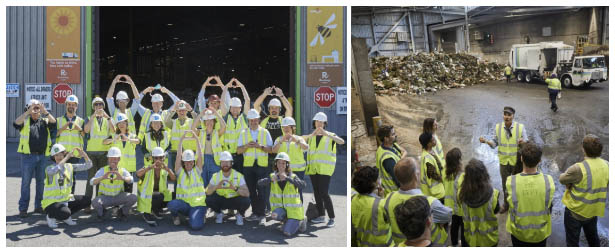
NextGen Circular Business Accelerator teams tour San Francisco’s waste recovery center, Recology.
Seek an informed perspective. Learning from experts, Accelerator teams toured waste management expert Recology’s facilities to better understand the technological capabilities and market forces affecting the local Bay Area recovery infrastructure. During the visit, teams had the opportunity to run their products through Recology’s recycling lines to gather real-time performance data. Teams also heard from Kate Daly, Managing Director at Closed Loop Partners, who shared a macro-perspective on global trends in recovery and reuse, and helped the teams think big picture—connecting upstream innovation to downstream recovery.
“Alignment between the design of cups and infrastructure is critical for capturing materials at every phase of a cup’s life cycle. It’s also important that as we continue to design for a better, more sustainable future, our infrastructure evolves too.”
Map the journey ahead. With these insights in mind, it was time to pull it all together. To get started, we helped teams consider their product journey, including all the people engaged along the way. The teams created a Post-It to represent every actor—from raw material producers and manufacturing technicians to corporate and distribution partners, consumers, and waste management experts—and made note of their specific needs as identified through research. Between actors, we drew lines to represent relationships: those that already existed, and those that each team needed to build in order to scale their solutions.
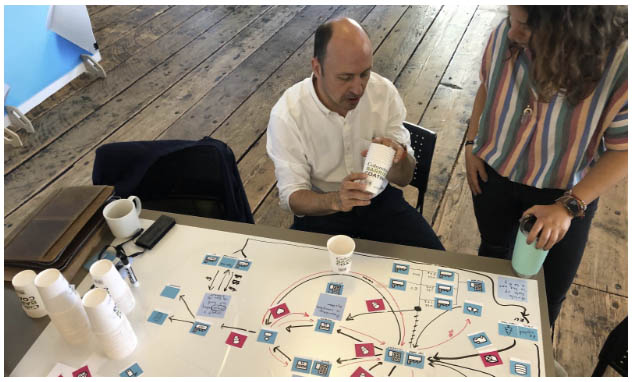
Ecosystem mapping with Henrik Björnberg, Chair of Colombier Group. Winning Cup Category: Innovative Cup Liner
The takeaways from the ecosystem mapping process set the Accelerator teams up with an actionable roll-out plan that identified their place within the existing infrastructure and who they needed to build partnerships with in pursuit of a fully circular, sustainable cup system.
Try it:
- Try out this product journey mapping exercise, then imagine new partnerships that could strengthen your network.
All together, these five design thinking practices helped our NextGen Accelerator teams gain a deeper understanding of the complex micro systems and macro infrastructure their products need to serve, while enabling Consortium Partners to quickly surface business realities and sticking points, helping to de-risk and accelerate the roll-out of new cups worldwide.
While not everyone can embark on a research sprint through futuristic waste recovery facilities and McDonald’s back-of-house experiences, anyone can apply design thinking practices to uncover fresh insights.
When addressing a problem that requires systemic change—prep, observe, interview, seek analogous inspiration, and map it out. The result could be some powerful new thinking, or perhaps even the holistic, circular cup of the future.
What’s Going on in China: Recycling’s Rise to Power
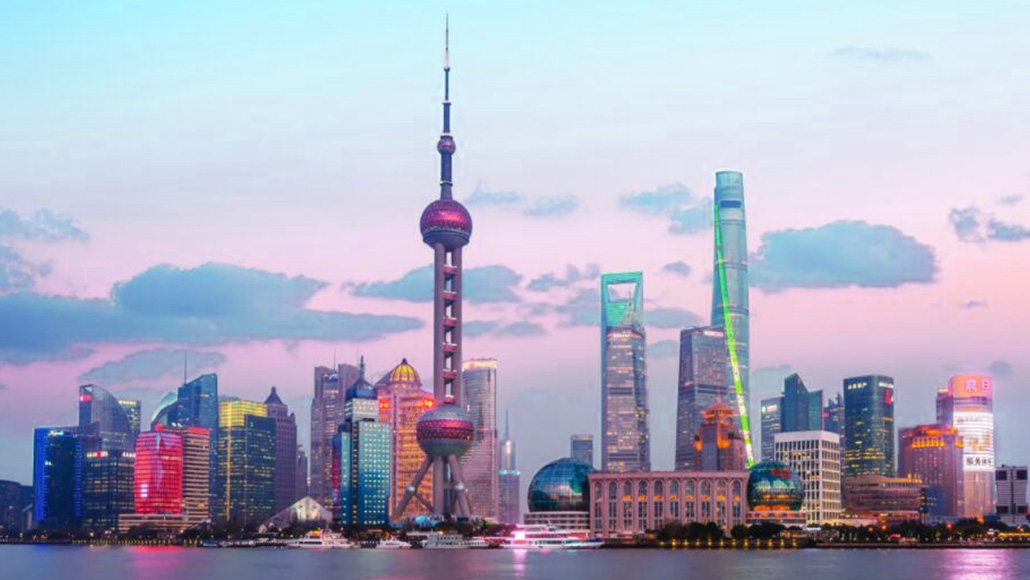
Chris Cui, Director of China Programs, builds bridges between the U.S. and Asia in order to advance the circular economy. She brings 13 years of cross-sector experience in financial service and philanthropy sectors in Asia, Europe and the U.S., advising Fortune 500’s emerging market strategies to capture growth potential from Asia.
The U.S. as well as other developed countries were taken by surprise when the Chinese government implemented a ban on the importation of recyclables on January 1, 2018. However, the Chinese government had been sending signals for the past decade of their future plans around both the importation of recyclables and the development of domestic recycling infrastructure.
Eight cities in China were selected as pilot cities for pilot recycling programs as far back as 2000 in order to study the most effective programs. Recycling gained significant attention in June 2019 when Chinese President Xi stressed the importance of cultivating the good habit to improve the living environment and to contribute to green and sustainable development.
“Trash classification is related to the people’s living environment and the economical use of resources. It is also an important embodiment of the level of civic-mindedness. Extensive education and guidance should be carried out to make the people realize the importance and necessity of garbage sorting.”
Chinese President Xi
It’s very rare that the top leader, rather than the Ministries in charge of the industry, make such strong statements about recycling.
Importantly, it demonstrates the priority that China has placed on the development of its own domestic recycling programs and infrastructure, as part of its effort to combat environmental issues that threaten the health of its 1.4 billion citizens. It also explains why China carried out the ban in the first place; they are continuing to shift their focus to developing domestic recycling infrastructure to feed their massive manufacturing base. Xi has made clear that the public sector will support the private sector to develop infrastructure to turn “waste” into opportunity.
So, what does this look like?
The Chinese government aims to increase recycling rates to 35% for residences by 2020, they’re building basic trash sortation systems and starting to charge waste management fees for both residential and commercial waste for 46 major cities by the end of 2020. They’re also expanding their trash classification system to all cities by 2025.
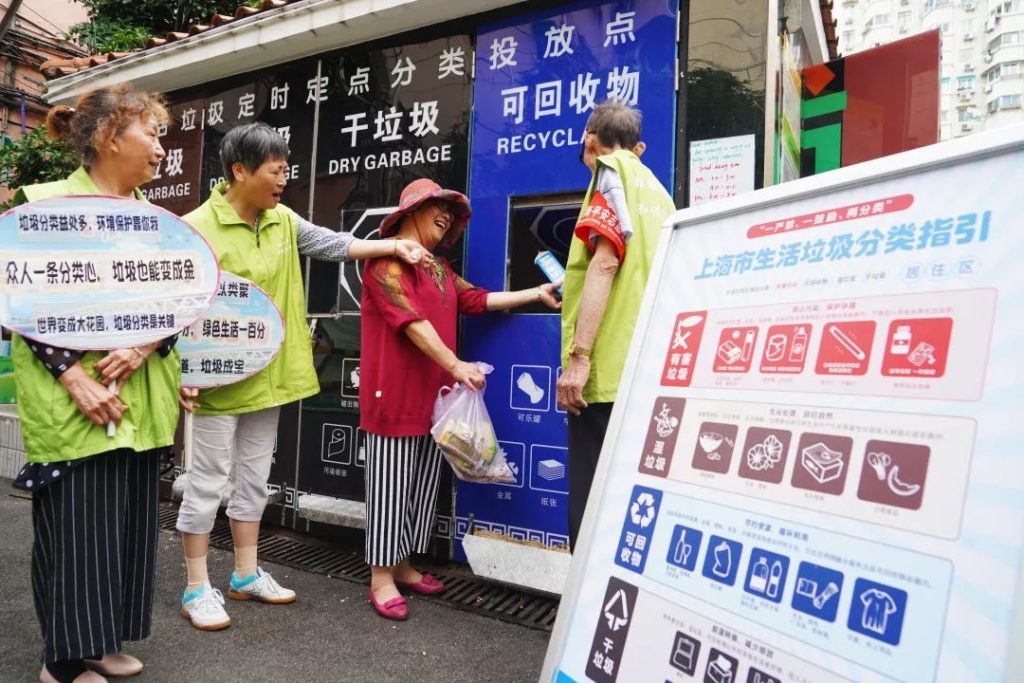
The four new trash sortation categories in China.
Image source here.
Case Study: Shanghai
Shanghai is one of the first cities to start responding to the policies from Central Government. Twenty-three million people must learn to sort their trash according to four labels – recyclables, dangerous goods, kitchen waste and other waste – under a mandatory sorting scheme starting on July 1. Misclassification will result in a fine of up to USD 30 for individuals, USD 7,200 for commercial entities and USD 70,000 for recyclers (and the potential revoking of their licenses). How to sort trash correctly is not just in the news, it’s the talk of the town and it’s even included in exam questions for schools.
For individuals who fail to sort their trash, their social credit rating, which not only determines their mortgage rate and insurance premium, but also their eligibility to purchase flight tickets and even send their kids to public schools, will be lowered.
Unsurprisingly, these new developments in recycling bring challenges, particularly around education and infrastructure. The Shanghai government has hired 1,700 instructors, conducted 13,000 training sessions, and created an app to handle enquiries to help citizens meet the requirements.
Meanwhile, the policy highlights the current lack of infrastructure for this kind of scheme. There needs to be significant investment from both the public sector and private sector to sufficiently grow the collection and sortation capabilities of the country. This especially applies to rural regions, which constitute a large proportion of China and lack the necessary infrastructure to deal with trash, especially tricky waste such as fertilizers and pesticides.
Yet all of these shifts have culminated in, and created, a significant business opportunity. Recycling needs investment now. China’s planned economy means that every five years, the central government will create an economic development plan for the country for the next five years. Key sectors that are targeted in the five-year plan will receive support, from specific policies to financial subsidies, that attract significant interest from the private sector. The recent emphasis on the recycling sector is a good example of this and, importantly, sends a positive signal to the market.
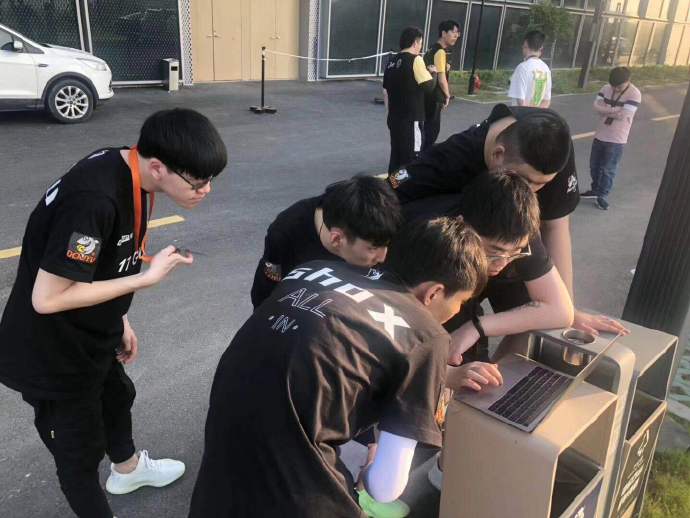
Residents in Shanghai search the internet for guidance on how to sort trash correctly.
Image source here.
The Business Opportunity Is Vast and Growing
At Closed Loop Partners, we know that keeping valuable commodities circulating in supply chains is good business. The current developments in China are spurring interest, excitement and investment in the space, which will continue to grow. There is room for both startups and bigger companies, domestic as well as foreign players, traditional players in the recycling industry and new players from other sectors like tech, marketing or consumer goods companies; all of whom are ready to innovate and embrace the change. We’re seeing a new structure of supply and demand around recyclables worldwide. Shanghai is just the beginning; more cities and business opportunities will arise in the coming years as a result of the combination of favorable factors:
The public markets are all in
With preferential policies and hundreds of billions of dollars to support the campaign, stocks have been rising for companies that supply equipment, chemicals and other services related to recycling.
The private sector is paying attention
More and more startups are emerging to solve the waste management problem in China, with some managing to raise money from mainstream VCs such as Alibaba, Baidu and Tencent. Robots for sortation, like AMP Robotics, or mobile apps for smart recycling stations or second hand mobile phones are just some examples of the innovations applicable in the field.
Demand for recycling related equipment and services is growing
As more cities follow the example of Shanghai and start mandatory urban trash recycling, related sales will jump significantly; sales of the smart trash bin on JD.COM soared by 613% between June 1-13 and it’s estimated that Shanghai residents bought 12% of the smart trash bins sold nationwide.
Sustainable packaging will be encouraged
Innovations in sustainable packaging will be welcomed by brands. Policies have been drafted on EPR in China for the packaging industry.
Opportunities for completely new business models are emerging
Challenges in the enforcement of trash classification means there are opportunities for entirely new business models to solve for the new pain points. For example, startups are offering online booking services for on-demand trash pickers and sorters that will come to your home.
If you’re interested in learning more on this topic, get in touch with Chris Cui and join us at these upcoming events:
- 14th China International Plastic Recycling Conference & Exhibition 2019, Sep 25-27, Shanghai, China. Closed Loop Partners is a co-organizer and will give the keynote.
- The Fortune Global Sustainability Forum 2019, Sep 4-6, Yunnan, China. Closed Loop Partners will be speaking on a panel.
Key Takeaways from the Largest North American Circular Economy Conference
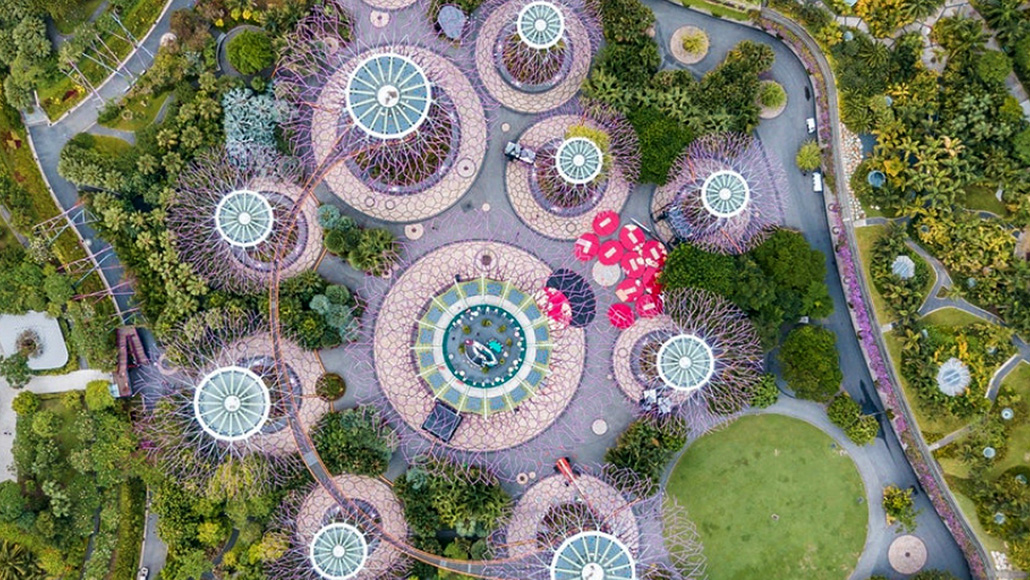
It was a momentous moment in Minneapolis last week as more than 800 people convened for Circularity 19, the largest conference in North America devoted to advancing the circular economy. In acknowledging the world’s finite resources and increasingly volatile supply chains, transitioning to a system that keeps valuable materials in circulation at their best and highest use has become a no brainer. In fact, it’s what many companies have been doing for a long time; Caterpillar has been remanufacturing products since the nineties.
Although not an entirely new concept, supporters of the circular economy are now reaching a critical mass. Consumers and companies alike want a more sustainable economic model. Now we have the appropriate framework: the circular economy. This doesn’t predicate itself on infinite resources; it reduces costs, creates jobs and protects our environment. From large brands like Google and 3M to students, NGOs, financiers and community activists, there was significant momentum behind Circularity 19.
Together, conference attendees watched startups pitch circular solutions such as reusable cup systems, explored the potential of materials marketplaces, and learned about transformational technologies that turn waste plastics back into the building blocks for new materials. All of these examples demonstrated the benefits of keeping valuable materials in circulation.
What was clear was that the circular economy isn’t a nice to have, it’s a need to have. Companies and individuals can’t afford to throw away the valuable rare earth elements in their phones or to ignore the intrinsic value of waste plastics that can reduce our dependence on oil extraction.
An overarching theme of Circularity 19 was around the power and responsibility that inevitably comes with advancing any new system; the importance of making sure the circular economy doesn’t suffer from the same ailments of the past linear “take-make-waste” system. Three areas in particular continued to come up in conversation:
The need for a just and equitable circular economy from the start
There needs to be a greater focus on the social elements of the circular economy; historically underrepresented groups, particularly lower income communities of color, are often disproportionately affected by environmental injustices. In a panel on Power, Privilege and Bias in a Circular Economy, speakers highlighted the importance of including everyone at the table from the very beginning, flagging the need for awareness and intentionality around what signals are being sent when developing a new system. There is also a need for thinking about how the success of circularity is measured from both a business and social standpoint; defining shared metrics for a truly regenerative, healthy, circular society is critical.
The importance of healthy materials and safe chemistry in the circular economy
It’s simple. In a circular economy valuable materials are kept in play, cycling in perpetuity, so the materials of choice must be safe and high quality. What does this really mean? Materials must be evaluated, tested and designed with their next life in mind – what happens when these materials come into contact with your skin? What about with the soil? If something is comprised of mixed materials, for example treated for flammability to serve a particular purpose in their first life, can these materials ever be food grade quality in their second life? These are the kinds of questions that were facilitated and fostered at Circularity 19, helping attendees to think through unintended consequences.
The urgent need for industries to collaborate outside of their comfort zones
A common thread throughout Circularity 19 was the need for unlikely bedfellows in order to achieve systemic, circular change. It takes more than just one industry. For example, the fashion industry can and must learn from the chemicals industry. The technologies emerging from the latter have important applications for the former, including chemical recycling technologies to process polyester garments at the end of their first life. Similarly, the tech industry has spent years investing in the development of RFID technologies and other tracking systems for the digital economy. But not enough organizations are applying these learnings to fashion. There is huge potential for weaving RFID technologies into garments so that stakeholders can keep track of their products’ lifecycles. Scanning tags and seeing that a garment is made of 100% linen and from a certain brand is valuable information that can influence the next life of a product – is it best for resale? Or is it best to recycle the product into fibers to create a new garment?
Throughout Circularity 19, it was encouraging to see how much progress has been made on circularity, as well as important to see how far we still have to go on this journey. By sharing knowledge and continuing to have productive conversations with diverse stakeholders, the conversation can be pushed forward. It was heartwarming to be a part of Circularity 19 this year and we look forward to Circularity 2020 in Georgia.
Investable Opportunities to Stem the Tide of Ocean Plastic Pollution and Build a Circular Economy

With only 9% of the world’s plastics getting recycled and global plastics demand forecasted to triple by 2050, we’re in desperate need for tangible, investable solutions to avert a crisis. Where ten years ago, the urgent need to broach this subject was met with resistance, today the conditions are altogether different.
Across the globe, movements such as Break Free From Plastic and legislation like the EU’s Circular Economy Action Plan have galvanised the public. Shocking images of sea turtles maimed by straws or statistics about there being more plastic than fish in the sea by 2050 have struck a chord.
It’s clear we must rethink our current leaky, linear system and shift to something more circular. We need a system that’s consciously designed to use less materials in the production and delivery of products and that keeps materials in circulation at their highest value for as many generations as possible, if not infinitely. This way we can reduce our waste and our extraction of raw materials.
Sometimes plastic is the most appropriate material to serve a purpose, given its particular properties, other times it’s not. There is no silver bullet approach. We need to invest in both near term solutions and long term solutions with clear paths to scaling to tackle the problem of ocean plastic pollution and reduce overall environmental impacts.
The good news: we’re already seeing clear, investable solutions that can shift us in the right direction.
There are at least 60 technology providers developing transformational technologies that purify, decompose, or convert waste plastics into renewed raw materials in North America, representing a $47 billion opportunity in North America alone. Many of these technologies mean there is no limit to the number of times plastics can be recycled, thereby helping us to shape a more circular economy for plastics.
Other companies are exploring innovative new delivery models or alternative materials science. Their outputs could supersede the need for plastic packaging altogether, whether through vending machines that dispense exact amounts of product into reusable containers like Algramo, new feedstocks replacing styrofoam packaging like TemperPack or through hyper-compostable, edible straws made of sustainably harvested seaweed like Loliware.
Large banks and brands are getting on board too, recognizing the need for change. Institutions like Goldman Sachs, Citi, Comerica Bank and Engie have co-invested in our funds in order to catalyze the development of the circular economy.
If we’re to stem the tide of plastic pollution in our oceans, it’s critical that we invest across the value chain and in companies that are rethinking the system for a more sustainable future. With the current enabling conditions, from policy to consumer engagement, now is the time to do it.
This blog was inspired by the discussion in Confluence Philanthropy‘s webinar on Exploring Investor Solutions to Restore the Ocean, which I participated in with Mark Spalding, President of The Ocean Foundation, Conrad MacKerron, Senior Vice President of As You Sow, and Angela Howe, Legal Director of Surfrider Foundation.
Sustainable Packaging Coalition and Center for the Circular Economy at Closed Loop Partners Announce Winner of the FlexPack Recovery Challenge
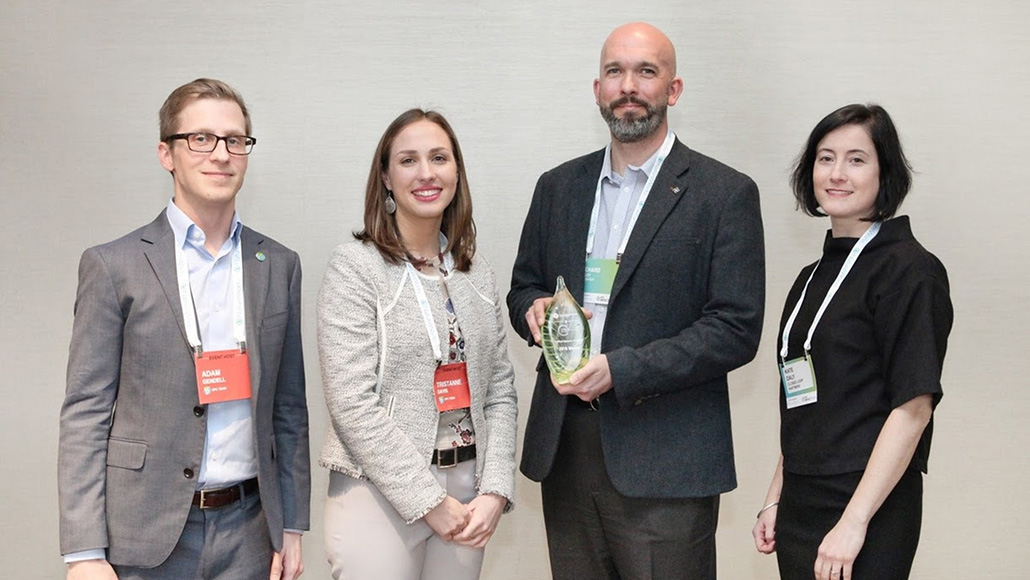
Start-ups from across the globe showcased their recovery technologies for a fast-growing category of hard-to-recycle flexible plastic packaging, and one winner was selected to join a mentorship program with the Sustainable Packaging Coalition & Closed Loop Partners.
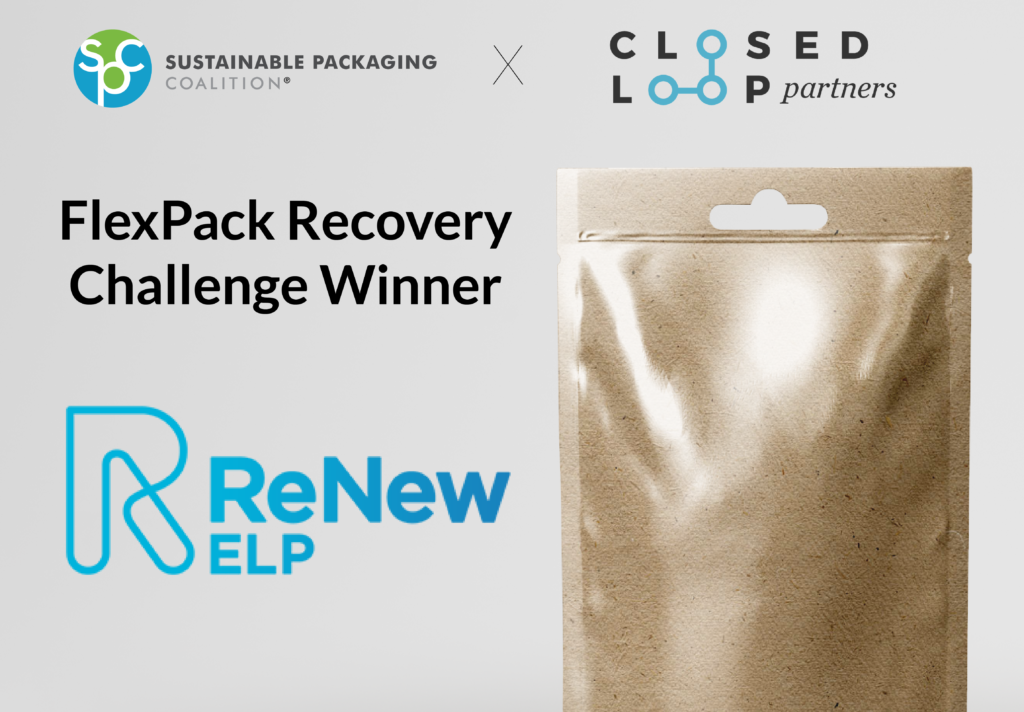
CHARLOTTESVILLE, VA and NEW YORK, NY — the Center for the Circular Economy at Closed Loop Partners and the Sustainable Packaging Coalition (SPC) have announced the winner of the FlexPack Recovery Challenge: ReNew ELP.
In October 2018, the SPC and the Center for the Circular Economy at Closed Loop Partners launched the FlexPack Recovery Challenge, an open competition for innovators, entrepreneurs, and start-ups to submit new ideas for reprocessing technologies capable of beneficially recovering multi-material flexible packaging waste.
Five finalists were selected by a panel of judges from the SPC and the Center for the Circular Economy at Closed Loop Partners staff, as well as with input from industry advisors. Each finalist participated in the SPC’s spring conference SPC Impact and presented to an audience of major brands, plastic manufacturers, and packaging suppliers, including members of the SPC’s Industry Leadership Committee on Multi-Material Flexible Recovery, on how their technologies can beneficially recover the embodied environmental investment within multi-material flexible packaging waste and can be scaled to provide meaningful solutions. These finalists included Cadel De-Inking, ReNewELP, Renewlogy, Synova-BioBTX, and Ekopolimer. Read more about all of our finalists.
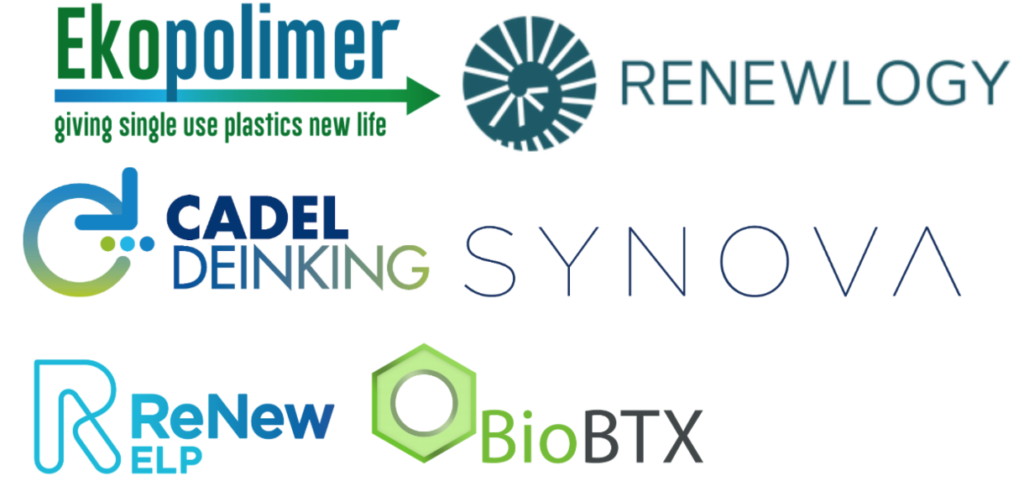
Among the five finalists, ReNewELP was selected as the final Challenge winner. RenewELP will receive a free year of membership to the SPC and enter into a mentorship program jointly run by the SPC and Closed Loop Partners.
“RenewELP submitted a detailed, transparent process description and market analysis. We were impressed with the processing capacity scale (up to 80,000 -100,000 tons per year in their initial facility) and the fact that their unique CAT-HTR technology allows for mixed waste feedstocks, including paper, PET and organics. Their modular approach considers variable material costs in different markets and their end markets for diverse hydrocarbon products like oils, waxes, and chemicals represent large market potential. RenewELP is a great fit to participate in a mentorship program run by our organizations,”
said representatives from the SPC and Closed Loop Partners in a joint statement.
The SPC & The Center for the Circular Economy at Closed Loop Partners team followed up with Richard Daley, Managing Director of RenewELP, for a post challenge interview.
Read the Q&A with Richard here
The SPC and CLP believe that all of technologies presented by the Finalists represent the kinds of diverse solutions needed for recovery of flexible packaging. We look forward to staying in touch with all the finalists and tracking and promoting their progress.
Learn more about the FlexPack Recovery Challenge.
ABOUT THE CENTER FOR THE CIRCULAR ECONOMY AT CLOSED LOOP PARTNERS
The Center for the Circular Economy brings together industry experts, academic researchers, and entrepreneurs who are solving for today’s most pressing challenges in design and reuse, providing a collaboration center for innovators to commercialize products, services and technologies that are leading the transition from a linear take, make, waste economy to a restorative one in which materials are shared, re-used, and continuously cycled.
ABOUT THE SUSTAINABLE PACKAGING COALITION
The Sustainable Packaging Coalition is a membership-based collaborative led by an independent non-profit that believes in the power of industry to make packaging more sustainable. Using an objective life-cycle-based approach, we work in a constructive atmosphere to provide thought leadership and bring our members together to strengthen and advocate the business case for more sustainable packaging.
